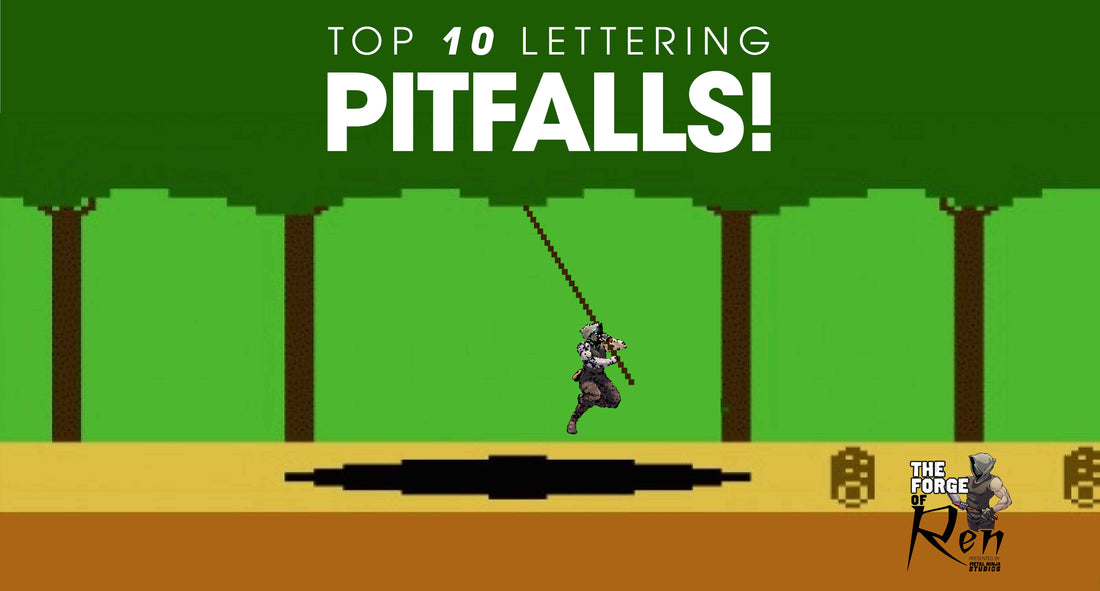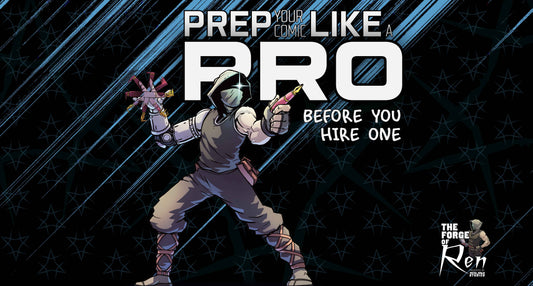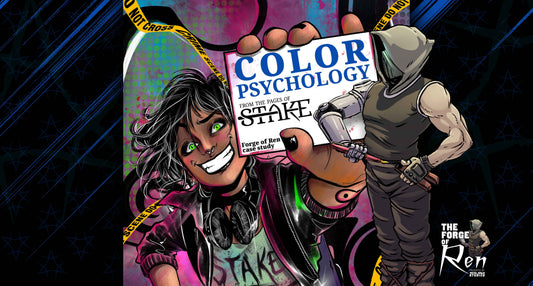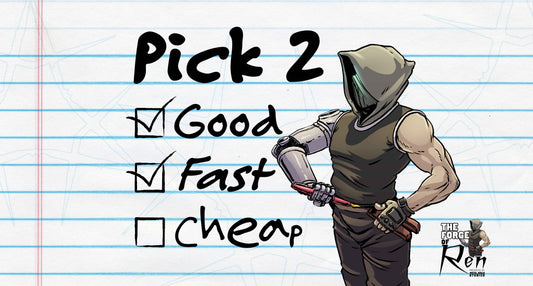Introduction
Lettering is an essential, but often overlooked, aspect of comic book production. A letterer's job goes beyond placing text on the page—they ensure the story flows naturally, dialogue is easy to follow, and the overall presentation complements the artwork. Inexperienced letterers, however, can unintentionally disrupt the reader's experience, detracting from the story and visuals. This blog explores ten common pitfalls amateur letterers make and how to avoid them.
Section 1: The Role of a Letterer
Comic book lettering is far more than just adding words to a page; it is a dynamic and creative process supporting storytelling. A letterer ensures that speech balloons, captions, and sound effects enhance the story's pacing, tone, and clarity. They work to guide the reader's eye seamlessly through the panels in the correct order, ensuring that the narrative flows naturally without confusion.
A letterer's responsibilities also include balancing the text with the artwork. Effective lettering complements the visuals, emphasizing emotional moments without overwhelming the art. For example, a well-placed caption can amplify suspense, while dynamic sound effects can bring action scenes to life. Beyond artistic considerations, technical precision is key. Professionals pay close attention to font choices, spacing, and placement to maintain readability while preserving the aesthetic of the comic.
Ultimately, a skilled letterer is an invisible storyteller. When done correctly, their work seamlessly integrates with the art and writing, enhancing the reader's experience. When done poorly, however, it can distract and detract from the story, emphasizing their critical role in the creative process.
Section 2: Ten Common Pitfalls of an Inexperienced Letterer
1 - Illegible Text
Legibility is the cornerstone of effective comic book lettering. Amateur letterers often choose fonts that are too ornate, small, or poorly spaced, making dialogue difficult to read. Additionally, inconsistent kerning (spacing between letters) or leading (spacing between lines of text) can disrupt the flow of the text, pulling readers out of the story. A professional letterer ensures that every piece of text is clear and easy to follow without compromising the visual style.

The above is an example of illegible text, and choosing style over function. While the selected font was designed for comics, it's intended as a design font, not dialogue. A design font is used for things like captions, logos, and "design" elements. They're meant to be large and bold, so they are much harder to read when used in a dialogue situation.
2 - Awkward Text Placement
Improper text placement can ruin the reader's experience. Speech balloons or captions that block key elements of the artwork diminish the visual impact. One of the most common rookie mistakes is creating "crossed tails," where the tails of speech balloons overlap, confusing the reader about who is speaking. Proper planning and understanding panel composition helps prevent these issues, ensuring the dialogue naturally guides the eye across the page.

Above are two examples of possible balloon placement. The first showcases poor planning that results in crossed tails. Crossed tails are one of the biggest tells of an inexperienced letterer. Don't let them happen! The second show strategically placed balloons that guide the readers eye without interfering with the art.
3 - Inconsistent Balloon Design
Variations in balloon shapes, sizes, or stroke thicknesses can create a disjointed reading experience. For instance, a jagged balloon edge meant to indicate shouting might look inconsistent if it differs greatly between panels. Maintaining uniformity in design—while reserving stylistic changes for specific narrative effects—ensures visual cohesion throughout the comic.

The above example showcases how two different styles can be overly distracting. More can be stated about the amount of contrast that should be used to properly differentiate varying styles in the same comic, but that's a topic for another blog.
4 - Overcrowded Panels
Too much text crammed into a single panel can overwhelm the artwork and make the page feel claustrophobic. Inexperienced letterers may struggle with proper balloon breaks (where text is divided into separate balloons) and balloon connections (whether balloons are joined, connected, or separated). Skilled letterers use these techniques to space text effectively and balance the flow of conversation. With the writer's approval, they can also adjust text placement between panels while maintaining the story's pacing and preserving the writer's intent, ensuring a seamless and engaging reading experience.

The above is an example of how too much text can overwhelm a panel, often diminishing the artwork and ruining any feeling of depth and dimension. These situations can usually be rectified through a combination of lettering techniques and collaboration with the writer and editor.
5 - Improper Font Usage
The wrong font can completely derail a comic's tone. For instance, a horror story using a playful, whimsical font for dialogue will confuse readers and diminish the intended impact. Amateur letterers often rely on default or generic fonts. At the same time, professionals select or design typefaces that align with the story's genre, mood, and aesthetic.

The above showcases how font selection is a powerful tool when properly used. The font selected can change the tone of the story, either amplifying the writer and artist's visions, or completely contradicting them. Make sure to have a firm grasp of the story's tone when developing the lettering style. Needing to reletter because of a poor design choice in the beginning can be a costly mistake.
6 - Poor Text Alignment
Misaligned text within speech balloons is a glaring sign of inexperience. Text that hugs one edge of a balloon or is awkwardly offset makes the lettering look sloppy and unprofessional. Clean, centered alignment not only improves readability but also enhances the overall polish of the comic.

Improper text alignment within your balloons can be drastic or subtle. Your reader will notice either way. The human eye is designed to pick up patterns, so it's easy to tell when something "feels" off. They may not be able to explicitly identify the problem, but the feeling of unease is undeniable. That's the power of typography.
7 - Lack of Emotional Expression
Dialogue without emotional nuance feels flat and lifeless. Inexperienced letterers may stick to a single font style or balloon shape, failing to convey tone or mood. Thoughtful font changes, such as bolding words for emphasis or adjusting balloon shapes to indicate shouting or whispering, add depth and dimension to the dialogue.

While the first option is not technically incorrect, it does a poor job of translating the emotion shown in the art. That lack of cohesion adds an additional point of tension that can pull your reader out of the story. It's the typographical equivalent of listening to a monotone audio book. Technically, it's not wrong...but that doesn't mean it's right or enjoyable.
8 - Ineffective Use of Balloon Air
The "air" inside speech balloons—the negative space around the text—is critical for visual balance. Balloons with too much empty space may look awkward and disconnected while taking up far too much space within a panel. Overcrowded balloons strain the reader's eyes and trigger subconscious feelings of anxiety and claustrophobia. Mastering the use of balloon air ensures that text is evenly spaced, creating a harmonious relationship between the dialogue and the artwork.

Maintaining an appropriate amount of air within your balloons is a combination of art and science. Each level of air may serve a different function, at a cost. For example, certain lettering styles may benefit from having extra air in the balloons, as it gives more of a whimsical and airy feeling to the dialogue. However, more of the art will be covered by each balloon. Conversely, restricting the air in a balloon can invoke feelings of claustrophobia and tension when used sparingly. While too much air can be a decision for a full lettering style, too little air should be used as infrequently as possible. It's all about finding balance.
9 - Inconsistent Style Throughout
Amateur letterers may inadvertently shift styles between pages or panels, using different fonts, balloon shapes, or text sizes. These inconsistencies disrupt the reader's immersion and make the comic feel disjointed. A professional letterer maintains a consistent style that aligns with the comic's overall aesthetic.

While leveraging different balloon styles can be an effective storytelling to, be sure to have a justifiable story-based reason for every new balloon and style. Varying styles should be used sparingly, otherwise your lettering runs the risk of becoming overwhelming and confusing.
10 - Overuse of Effects or Styles
While effects like bolding, balloon breaks, or stylized emphasis can enhance certain elements, excessive use often conflicts with the art, breaking the number one rule of lettering: to convey the story while complementing and highlighting the art. Inexperienced letterers may over-rely on these techniques to create impact, resulting in a visually noisy comic. Subtle, intentional use of effects maintains readability and ensures the lettering harmonizes the story and artwork.

Using emphasis and balloon effects can be a fun and easy way to add variety and impact to your lettering. However, it's just as easy to overdo. Lettering can become distracting when style takes precedence over function.
11 - BONUS - Advanced Pitfall: Not Having Fun
Lettering is as much an art as a science, and up-and-coming letterers sometimes hyper-focus on rules and forget to have fun with their craft. Rule-breaking can be a hallmark of creativity, but only if the rules are understood first. A skilled letterer knows when bending or breaking conventions enhances the story—whether it's experimenting with balloon shapes, text alignment, or even dialogue placement. Exploration and creativity thrive when rooted in knowledge, making lettering an enjoyable and fulfilling part of comic production.
Section 3: For Letterers - How to Avoid These Pitfalls
Avoiding these pitfalls requires training, experience, and practice. Here are some actionable tips:
- Study successful comics to understand effective lettering. Look for comics where the lettering enhances the story without distracting from it. Pay attention to qualities like consistent balloon placement, appropriate font choices, and how the letterer uses visual hierarchy to guide the reader's eye. For example, classic superhero comics often showcase dynamic sound effects, while indie comics may prioritize innovative font styles that match their tone.
- Learn how to balance text and visuals effectively. For instance, avoid placing speech balloons in a way that obstructs key parts of the artwork, like characters' faces or important background elements. Instead, position balloons strategically to complement the visual flow and guide the reader's eye. This approach keeps the reader's attention on both the dialogue and the artwork, maintaining narrative and visual harmony.
- Invest in quality tools and software specifically designed for comic book lettering. Recommended tools include Adobe Illustrator, Clip Studio Paint, and Affinity Designer for their robust vector editing capabilities. Software like FontForge or Glyphs can also be explored for advanced typography needs.
- Practice Makes Perfect: Try lettering using our free training segment! Click here to access unlettered comic pages and scripts. Test your skills and compare your work to professionally lettered examples.
Click Here for a FREE Lettering Practice Pack
Additional Resources for Custom Fonts
While Metal Ninja Studios does not offer custom typography or font creation, we highly recommend two industry leaders for high-quality comic book lettering fonts:
Comicraft: Known for their professional, versatile fonts tailored specifically for comics.
Blambot: Offers a wide range of comic fonts, from dialogue to sound effects, with styles suitable for any genre.
Section 4: For Creators - Benefits of Hiring a Professional Letterer
Hiring a professional letterer removes significant stress from a creator's shoulders. The pitfalls listed above are just a sample of the countless rules and best practices that professional letterers learn and refine daily. These experts spend years honing their skills in typography, graphic design, color theory, and other complementary disciplines to master the art and science of lettering.
By trusting a professional letterer, writers (or their editors) don't have to worry about gaining decades of specialized knowledge. Instead, they can rely on the team they've assembled, freeing up time to focus on their own talents and the numerous tasks required for a successful comic launch, such as marketing and promotion.
Metal Ninja Studios amplifies this value by leveraging our in-house team of letterers, editors, and graphic designers. This collaborative "hivemind" process ensures every project undergoes rigorous internal review, resulting in the highest-quality work. Our goal is to provide creators with a stress-free experience, giving them a "delivery day is like opening presents on Christmas" feeling as they enjoy their comic in its final form for the first time—without any worry or hassle.
Conclusion
Lettering is an essential craft that bridges the gap between art and story, turning a comic into a seamless, immersive experience. From avoiding pitfalls like illegible text and poor placement to mastering advanced techniques that enhance storytelling, a skilled letterer can make a significant difference in the final product.
The pitfalls listed above highlight the complexity of the craft and showcase why hiring a professional is invaluable. By trusting a seasoned letterer, creators can focus on their unique talents, leaving the technical and creative lettering challenges in expert hands.
At Metal Ninja Studios, we bring together a team of experienced professionals who understand the nuances of lettering and comic production. Let us handle the details while you enjoy the magic of seeing your story come to life in its best possible form.
Ready to collaborate? Reach out to Metal Ninja Studios today, and let us help you create a comic that stands out from the crowd.





